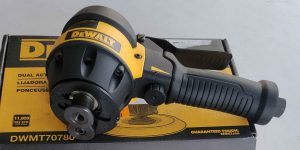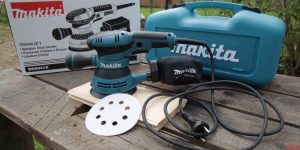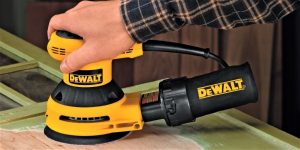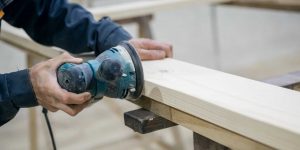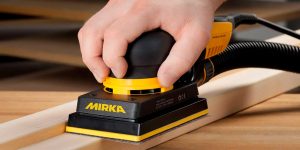When it comes to the world of sanding, understanding the tools at your disposal is paramount. The debate between DA vs orbital sander is a common one, especially for beginners and DIY enthusiasts. Why? Because the right sander can significantly influence the outcome of your project, making the distinction between these two tools critical for various sanding tasks. In this article, I will help you make the right decision and understand when and for which tasks it is better to use a certain tool.
Overview of dual action sander

A Dual Action (DA) sander, often called a random orbital sander, operates uniquely, setting it apart from traditional orbital sanders. This principle is the main trump card in the dual action sander vs orbital sander debate. Below is a comprehensive breakdown of such devices’ characteristics, functions, and applications
Main functions and features:
- Variable speed control: Allows the user to adjust the sander’s speed for different tasks.
- Dust collection: Most DA sanders come with dust collection ports to minimize airborne dust.
- Vibration reduction: Enhanced user comfort during extended periods of use.
Typical applications:
- Preparing surfaces for painting or staining.
- Smoothing out rough patches on wood or metal.
- Final finishing touches to eliminate visible marks.
Pros and cons:
| Pros | Cons |
|---|---|
| Even and swirl-free finish | Slightly more expensive |
| Versatile with multiple surfaces | Requires a bit of practice |
| Reduced vibration | Not as aggressive as belt sanders |
Overview of orbital sander

Orbital sanders, distinct from the dual-action or random orbital sanders, bring their own set of advantages and functionalities to the sanding realm. As I mentioned before, in the DA sander vs orbital sander discussion, understanding these distinctions is important. Here’s a detailed insight into the world of orbital sanders.
Main functions and features
- Simple operation: Easy for beginners to grasp and use effectively.
- Compact design: Suitable for tight spaces and edges.
- Dust collection: Many models include ports or bags for dust collection.
Typical applications:
- Light sanding tasks.
- Finishing operations on flat surfaces.
- Sanding in tight corners and edges.
Pros and cons:
| Pros | Cons |
|---|---|
| Simple to use | More noticeable sanding marks |
| Affordable | Less efficient for heavy-duty tasks |
| Lightweight and ergonomic | Limited to mainly flat surfaces |
Comparison factors
Selecting between a Dual Action (DA) sander and an orbital sander largely depends on your specific needs and preferences. In the context of the dual action sander vs random orbital debate, it’s important to understand their unique attributes. Let’s explore the major comparison factors to help you make an informed decision.
| Comparison factors | Dual action sander | Orbital sander |
|---|---|---|
| Sanding action and performance | Utilizes a dual movement to prevent consistent abrasive patterns, leading to a swirl-free finish. | Uses a straightforward circular motion which can leave more evident sanding marks. |
| Control and precision | Offers more control due to its dual motion but may require some practice to master. | A simpler design offers less precision but is straightforward and easy to control. |
| Versatility and adaptability | Effective on multiple surfaces and adaptable for varied tasks due to variable speed settings. | Best for flat surfaces and light sanding tasks; not as adaptable for heavy-duty operations. |
| Speed and efficiency | The dual-action movement can handle tougher jobs with ease but might not be as fast for simpler tasks. | Generally quicker for straightforward, light tasks due to its singular motion. |
| Dust collection and management | Most models come with advanced dust collection ports, ensuring cleaner operation. | Many models have basic dust collection features, but it may vary based on the model and brand. |
| Price and affordability | Tend to be more expensive due to their complex mechanism and versatility. | Typically more affordable, making them a go-to choice for beginners or those on a budget. |
When making a choice between a DA tool and an orbital sander, understanding these factors is critical. While the DA sander is seen as the more versatile tool with superior finishing qualities, the orbital sander stands out for its simplicity, affordability, and efficiency in certain tasks. Your decision should align with the nature of your projects, budget, and desired outcomes.
Selecting the right tool for different tasks

Each sanding project has its own set of requirements, and choosing the right tool can drastically influence the end result. Here’s a guide to help you select between a Dual Action (DA) sander and an orbital sander for specific tasks:
- Preparing car paint:
- DA sander: Ideal for this task. The dual motion provides a smooth finish without leaving swirl marks, which is important for car paint preparation. Its variable speed can be adjusted to remove old paint or just to smooth the surface in preparation for a new coat.
- Orbital sander: Not recommended for car paint jobs, as the circular motion can leave visible sanding marks.
- Woodworking projects:
- DA sander: Effective for larger wooden surfaces, ensuring a swirl-free finish. Its versatility allows for both aggressive removal and fine finishing.
- Orbital sander: Suitable for light sanding tasks on wood, especially on flat surfaces. It’s also ideal for sanding corners and edges due to its compact design.
- Lacquering metal surfaces:
- DA sander: A good choice for preparing metal surfaces for lacquer, especially if the surface is sizable or you’re aiming for a mirror-like finish.
- Orbital sander: Can be used for basic metal preparation tasks, especially if the metal piece is small. However, for finer finishes, a DA sander is preferable.
Practical recommendations:
- For professional projects or tasks requiring impeccable finishes (like car paint jobs), investing in a DA sander is wise.
- If you’re a hobbyist or a beginner looking for a tool for light tasks or specific woodworking jobs, an orbital sander could be both economical and effective.
- Always consider the surface size, desired finish, and your budget when making a decision.
In conclusion, while both sanders have their merits, understanding the nature of your project and desired outcome will guide you in the orbital sander vs DA sander debate, ensuring you select the most suitable tool.


